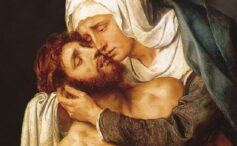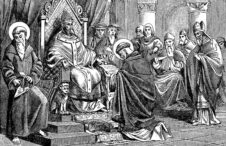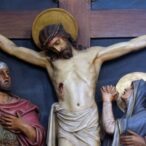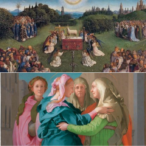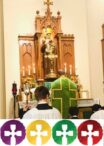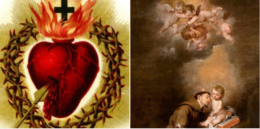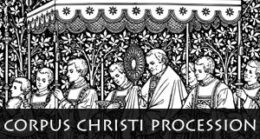Current events are seldom a consideration in choosing the hymns we will sing. On this Sunday, July 25, the 9th Sunday after Pentecost, we chose two hymns with current events in mind. More on that in a moment.
We’re into the green Sundays, second class feasts for which any of the following are fitting:
- Mass IV (for Ordinary Feasts)
- Mass VIII (for Second Class Feasts)
- Mass XI (for Sundays throughout the Year)
From among them, our preference (it is no more than that) is for Mass IV, and that works nicely with Credo IV. Our visiting priest, Father Horvath, likes the Ite Missa Est from Mass VIII, and that is what he sang, so we rolled right along with him!
We again went with Hail, Jesus, Hail as the processional hymn, in honor of the Precious Blood, during this, the month of the Precious Blood.
Of course, since we are no longer in Paschaltide, we sang the Asperges me (rather than the Vidi aquam).
The first instance in which current events influenced our choice was at the Offertory. We sang Stella Coeli Extirpavit, once again imploring Our Lady to beseech her Son, in our behalf, to end the current pestilence. This time, the men of the schola did it in three parts, in an arrangement that is distinctively medieval, and which was written by one of our men. We had a wee bit of time remaining so we also included the Regina Coeli, finishing just in time to avoid delaying Father and the Mass.
At the Communion, the mixed choir sang Aichinger’s Factus est repente. This is an interesting polyphonic mashup of the Communion antiphon (Factus est repente) and the Offertory antiphon (Confirma hoc Deus) from Pentecost Sunday. It is very fitting at communion time. We had sufficient time to also sing a few lines from Adoro te devote, a great classic from Thomas Aquinas.
Our recessional is one of the most stirring hymns in the hymnal, Let all mortal flesh keep silent. This is taken from the Liturgy of Saint James, whose feast day it was today.
Before his sermon, Father read the very moving letter from the Superior General of the FSSPX, Father (Don Davide) Pagliarnai. This was his response to the unfortunate Motu Proprio, Traditionis Custodes, which further restricts the availability of the Traditional Latin Mass. In this letter, Don Davide implores us to entrust our intentions to the Patroness of the FSSPX, Our Lady of Sorrows. Father Horvath made the same request of us in his sermon. In general, we do not like to improvise, but we decided, in view of this dual request, to sing the Stabat Mater, the Sequence from the Feast of Our Lady of Sorrows, after the recessional, as the faithful made their thanksgiving. And this was the second instance where current events influenced our decision.
